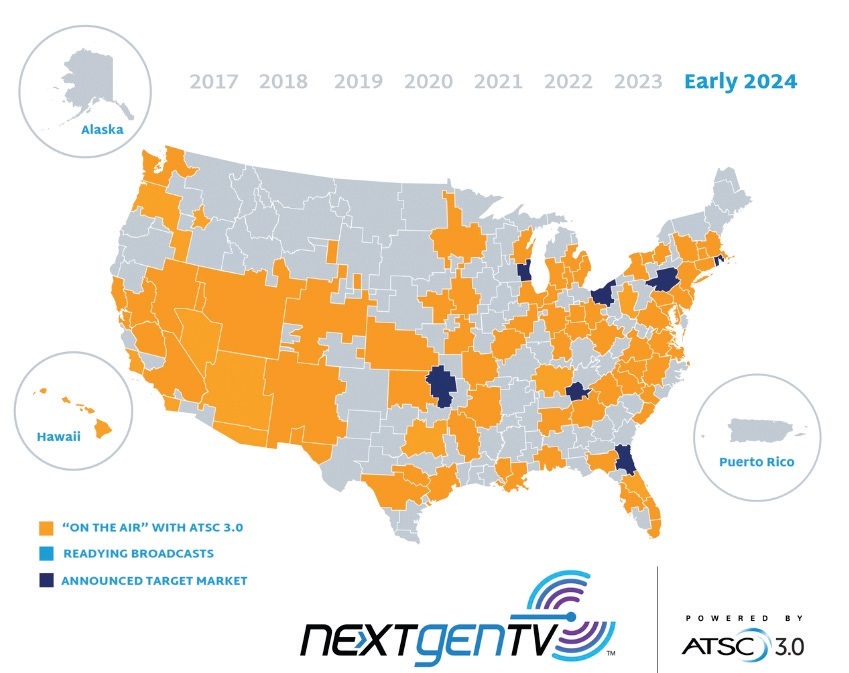
NAB Show provides an annual opportunity for broadcasters to gather in person and assess the progress the industry has made in its transition to ATSC 3.0. At this year’s event, broadcasters have a lot to be proud of, having achieved a number of significant milestones towards market deployments and new features.
In the past 12 months, ATSC 3.0 has been launched in New York, Chicago and Philadelphia, bringing at least 75 percent of U.S. households within reach of NextGen TV, a feat that deserves widespread recognition for the broadcast industry, according to Madeleine Noland, president of ATSC.
“We have sort of a golden number right now: 75 markets on air in 75 percent of the country,” she said, adding that transitioning the rest of the country will become more of a challenge. “What’s left is very hard to do and requires some additional thinking,” Noland said, adding that spectrum constraints and issues with determining host stations in smaller markets will be more difficult.
“We’re not going to get to 100 percent overnight, and that’s what the “Future of TV” initiative is studying,” she said, referring to a consortium of industry, government and public advocates that has been meeting under the guidance of the FCC to accelerate the transition. The group’s first report is expected to be released this summer or fall.
Noland noted several recent product announcements that could help spur further development of auxiliary devices for NextGen TV, as well as the announcement from TCL that it will begin offering ATSC 3.0 support in certain smart TV sets by the end of this year.
A number of new ATSC 3.0 consumer devices have hit the market over the past 12 months, including the introduction of the first set-top box certified to carry the NEXTGEN TV logo — the ADTH NextGen TV receiver from Atlanta DTH. At around $90, the device is among the most affordable of its kind on the market, a trend we need to see more of, according to Kerry Oslund, vice president, strategy and business development for EW Scripps and a new member of the ATSC board.
“The more receivers we have, the more business that we’re going to have — that is probably the biggest challenge to be solved,” he said. “And not only do we need receivers; we need affordable receivers.”
The professional video industry's #1 source for news, trends and product and tech information. Sign up below.
Those receivers also need security to help protect broadcasters’ content so the recent announcement of a new security protocol from the A3SA that will make it possible for CE companies to develop new 3.0 recording devices for home networks was welcome.
Deployments in some of the nation’s largest cities over the past 12 months
now bring NextGen TV to more than 75 percent of U.S. households.
“This is very good news,” Noland said. “The A3SA is working to make sure that all different use cases that people might want to employ in a consumer device can be handled in such a way that is respectful of the protection content producers expect.”
The latest devices from ADTH, Zapperbox, Zinwell and others will be on display at the ATSC’s booth in the West Hall, which will again provide a one-stop shop for all discussions ATSC 3.0-related.
Combining broadcast with IP, ATSC 3.0 offers an array of advanced features that consumers are eager to experience, including 4K, customized programming, DVR functionality, etc., but many broadcasters believe the current “killer app” to be HDR, an image-enhancing feature that Sinclair offers on its approximately 40 stations broadcasting 3.0.
Oslund is also focusing on the standard at the Show as well. “We will be very interested in all efforts in advancing adoption of HDR as the next step — change in improved picture quality — particularly as more and more live sports move back to broadcast television,” Oslund said.
Anne Schelle, managing director for Pearl TV agrees that HDR is “huge,” comparing broadcasters’ rollout of HDR with Max, which earlier this year became the first live-streaming platform to offer live sports in HDR10 or Dolby Vision.
“3.0 broadcasters already reach 24 million households in HDR right now,” she said. “We’ll be at 80 million by this summer in preparation for the Olympics.”
Schelle also expects an announcement on an initiative to use 3.0 to enhance audience measurement so broadcasters can better compete in an increasingly connected TV world.
Copyright NAB 2024.
Tom has covered the broadcast technology market for the past 25 years, including three years handling member communications for the National Association of Broadcasters followed by a year as editor of Video Technology News and DTV Business executive newsletters for Phillips Publishing. In 1999 he launched digitalbroadcasting.com for internet B2B portal Verticalnet. He is also a charter member of the CTA's Academy of Digital TV Pioneers. Since 2001, he has been editor-in-chief of TV Tech (www.tvtech.com), the leading source of news and information on broadcast and related media technology and is a frequent contributor and moderator to the brand’s Tech Leadership events.

